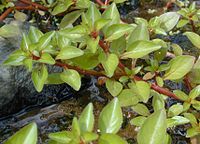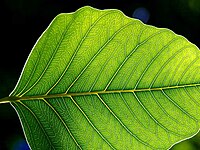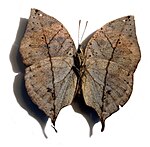Arrangement on the stem
Different terms are usually used to describe leaf placement (phyllotaxis):
- Alternate — leaf attachments are singular at nodes, and leaves alternate direction, to a greater or lesser degree, along the stem.
- Opposite — leaf attachments are paired at each node; decussate if, as typical, each successive pair is rotated 90° progressing along the stem; or distichous if not rotated, but two-ranked (in the same geometric flat-plane).
- Whorled — three or more leaves attach at each point or node on the stem. As with opposite leaves, successive whorls may or may not be decussate, rotated by half the angle between the leaves in the whorl (i.e., successive whorls of three rotated 60°, whorls of four rotated 45°, etc). Opposite leaves may appear whorled near the tip of the stem.
- Rosulate — leaves form a rosette
As a stem grows, leaves tend to appear arranged around the stem in a way that optimizes yield of light. In essence, leaves form a helixpattern centred around the stem, either clockwise or counterclockwise, with (depending upon the species) the same angle of divergence. There is a regularity in these angles and they follow the numbers in a Fibonacci sequence: 1/2, 2/3, 3/5, 5/8, 8/13, 13/21, 21/34, 34/55, 55/89. This series tends to a limit of 360° x 34/89 = 137.52 or 137° 30', an angle known mathematically as the golden angle. In the series, thenumerator indicates the number of complete turns or "gyres" until a leaf arrives at the initial position. The denominator indicates the number of leaves in the arrangement. This can be demonstrated by the following:
- alternate leaves have an angle of 180° (or 1/2)
- 120° (or 1/3) : three leaves in one circle
- 144° (or 2/5) : five leaves in two gyres
- 135° (or 3/8) : eight leaves in three gyres.
Divisions of the lamina (blade)
Two basic forms of leaves can be described considering the way the blade is divided. A simple leaf has an undivided blade. However, the leaf shape may be formed of lobes, but the gaps between lobes do not reach to the main vein. A compound leaf has a fully subdivided blade, eachleaflet of the blade separated along a main or secondary vein. Because each leaflet can appear to be a simple leaf, it is important to recognize where the petiole occurs to identify a compound leaf. Compound leaves are a characteristic of some families of higher plants, such as theFabaceae. The middle vein of a compound leaf or a frond, when it is present, is called a rachis.
- Palmately compound leaves have the leaflets radiating from the end of the petiole, like fingers off the palm of a hand, e.g. Cannabis(hemp) and Aesculus (buckeyes).
- Pinnately compound leaves have the leaflets arranged along the main or mid-vein.
- Bipinnately compound leaves are twice divided: the leaflets are arranged along a secondary vein that is one of several branching off the rachis. Each leaflet is called a "pinnule". The pinnules on one secondary vein are called "pinna"; e.g. Albizia (silk tree).
- trifoliate: a pinnate leaf with just three leaflets, e.g. Trifolium (clover), Laburnum (laburnum).
- pinnatifid: pinnately dissected to the midrib, but with the leaflets not entirely separate, e.g. Polypodium, some Sorbus (whitebeams).
Characteristics of the petiole
Petiolated leaves have a petiole. Sessile leaves do not: the blade attaches directly to the stem. In clasping or decurrent leaves, the blade partially or wholly surrounds the stem, often giving the impression that the shoot grows through the leaf. When this is actually the case, the leaves are called "perfoliate", such as in Claytonia perfoliata. In peltate leaves, the petiole attaches to the blade inside from the blade margin.
In some Acacia species, such as the Koa Tree (Acacia koa), the petioles are expanded or broadened and function like leaf blades; these are called phyllodes. There may or may not be normal pinnate leaves at the tip of the phyllode.
A stipule, present on the leaves of many dicotyledons, is an appendage on each side at the base of the petiole resembling a small leaf. Stipules may be lasting and not be shed (a stipulate leaf, such as in roses and beans), or be shed as the leaf expands, leaving a stipule scar on the twig (an exstipulate leaf).
- The situation, arrangement, and structure of the stipules is called the "stipulation".
Venation (arrangement of the veins)
There are two subtypes of venation, namely, craspedodromous, where the major veins stretch up to the margin of the leaf, andcamptodromous, when major veins extend close to the margin, but bend before they intersect with the margin.
- Feather-veined, reticulate — the veins arise pinnately from a single mid-vein and subdivide into veinlets. These, in turn, form a complicated network. This type of venation is typical for (but by no means limited to) dicotyledons.
- Pinnate-netted, penniribbed, penninerved, penniveined; the leaf has usually one main vein (called the mid-vein), with veinlets, smaller veins branching off laterally, usually somewhat parallel to each other; eg Malus (apples).
- Three main veins branch at the base of the lamina and run essentially parallel subsequently, as in Ceanothus. A similar pattern (with 3-7 veins) is especially conspicuous in Melastomataceae.
- Palmate-netted, palmate-veined, fan-veined; several main veins diverge from near the leaf base where the petiole attaches, and radiate toward the edge of the leaf; e.g. most Acer (maples).
- Parallel-veined, parallel-ribbed, parallel-nerved, penniparallel — veins run parallel for the length of the leaf, from the base to the apex. Commissural veins (small veins) connect the major parallel veins. Typical for most monocotyledons, such as grasses.
- Dichotomous — There are no dominant bundles, with the veins forking regularly by pairs; found inGinkgo and some pteridophytes.
Note that although it is the more complex pattern, branching veins appear to be plesiomorphic and in some form were present in ancient seed plants as long as 250 million years ago. A pseudo-reticulate venation that is actually a highly modified penniparallel one is an autapomorphy of some Melanthiaceaewhich are monocots, e.g. Paris quadrifolia (True-lover's Knot).
Leaf morphology changes within a single plant
- Homoblasty - Characteristic in which a plant has small changes in leaf size, shape, and growth habit between juvenile and adult stages.
- Heteroblasty - Characteristic in which a plant has marked changes in leaf size, shape, and growth habit between juvenile and adult stages.
Leaf terminology
Margins (edge)
The leaf margin is characteristic for a genus and aids in determining the species.
- ciliate: fringed with hairs
- crenate: wavy-toothed; dentate with rounded teeth, such as Fagus (beech)
- crenulate finely or shallowly crenate
- dentate: toothed, such as Castanea (chestnut)
- coarse-toothed: with large teeth
- glandular toothed: with teeth that bear glands.
- denticulate: finely toothed
- doubly toothed: each tooth bearing smaller teeth, such as Ulmus (elm)
- entire: even; with a smooth margin; without toothing
- lobate: indented, with the indentations not reaching to the center, such as many Quercus (oaks)
- palmately lobed: indented with the indentations reaching to the center, such as Humulus (hop).
- serrate: saw-toothed with asymmetrical teeth pointing forward, such as Urtica (nettle)
- serrulate: finely serrate
- sinuate: with deep, wave-like indentations; coarsely crenate, such as many Rumex (docks)
- spiny: with stiff, sharp points, such as some Ilex (hollies) and Cirsium (thistles).
Tip of the leaf
- acuminate: long-pointed, prolonged into a narrow, tapering point in a concave manner.
- acute: ending in a sharp, but not prolonged point
- cuspidate: with a sharp, elongated, rigid tip; tipped with a cusp.
- emarginate: indented, with a shallow notch at the tip.
- mucronate: abruptly tipped with a small short point, as a continuation of the midrib; tipped with a mucro.
- mucronulate: mucronate, but with a smaller spine.
- obcordate: inversely heart-shaped, deeply notched at the top.
- obtuse: rounded or blunt
- truncate: ending abruptly with a flat end, that looks cut off.
Base of the leaf
- acuminate: coming to a sharp, narrow, prolonged point.
- acute: coming to a sharp, but not prolonged point.
- auriculate: ear-shaped.
- cordate: heart-shaped with the notch towards the stalk.
- cuneate: wedge-shaped.
- hastate: shaped like an halberd and with the basal lobes pointing outward.
- oblique: slanting.
- reniform: kidney-shaped but rounder and broader than long.
- rounded: curving shape.
- sagittate: shaped like an arrowhead and with the acute basal lobes pointing downward.
- truncate: ending abruptly with a flat end, that looks cut off.
Surface of the leaf
The surface of a leaf can be described by several botanical terms:
- farinose: bearing farina; mealy, covered with a waxy, whitish powder.
- glabrous: smooth, not hairy.
- glaucous: with a whitish bloom; covered with a very fine, bluish-white powder.
- glutinous:' sticky, viscid.
- papillate, or papillose: bearing papillae (minute, nipple-shaped protuberances).
- pubescent: covered with erect hairs (especially soft and short ones).
- punctate: marked with dots; dotted with depressions or with translucent glands or colored dots.
- rugose: deeply wrinkled; with veins clearly visible.
- scurfy: covered with tiny, broad scalelike particles.
- tuberculate: covered with tubercles; covered with warty prominences.
- verrucose: warted, with warty outgrowths.
- viscid, or viscous: covered with thick, sticky secretions.
The leaf surface is also host to a large variety of microorganisms; in this context it is referred to as the phyllosphere.
Hairiness (trichomes)
"Hairs" on plants are properly called trichomes. Leaves can show several degrees of hairiness. The meaning of several of the following terms can overlap.
- arachnoid, or arachnose: with many fine, entangled hairs giving a cobwebby appearance.
- barbellate: with finely barbed hairs (barbellae).
- bearded: with long, stiff hairs.
- bristly: with stiff hair-like prickles.
- canescent: hoary with dense grayish-white pubescence.
- ciliate: marginally fringed with short hairs (cilia).
- ciliolate: minutely ciliate.
- floccose: with flocks of soft, woolly hairs, which tend to rub off.
- glabrous: no hairs of any kind present.
- glandular: with a gland at the tip of the hair.
- hirsute: with rather rough or stiff hairs.
- hispid: with rigid, bristly hairs.
- hispidulous: minutely hispid.
- hoary: with a fine, close grayish-white pubescence.
- lanate, or lanose: with woolly hairs.
- pilose: with soft, clearly separated hairs.
- puberulent, or puberulous: with fine, minute hairs.
- pubescent: with soft, short and erect hairs.
- scabrous, or scabrid: rough to the touch.
- sericeous: silky appearance through fine, straight and appressed (lying close and flat) hairs.
- silky: with adpressed, soft and straight pubescence.
- stellate, or stelliform: with star-shaped hairs.
- strigose: with appressed, sharp, straight and stiff hairs.
- tomentose: densely pubescent with matted, soft white woolly hairs.
- cano-tomentose: between canescent and tomentose.
- felted-tomentose: woolly and matted with curly hairs.
- villous: with long and soft hairs, usually curved.
- woolly:' with long, soft and tortuous or matted hairs.
In the course of evolution, leaves have adapted to different environments in the following ways:
- A certain surface structure avoids moistening by rain and contamination (See Lotus effect).
- Sliced leaves reduce wind resistance.
- Hairs on the leaf surface trap humidity in dry climates and create a large boundary layer thereby reducing water loss.
- Waxy leaf surfaces reduce water loss.
- Large surface area of leaf provides large area for sunlight and provides shade for plant to minimize heating and reduce water loss.
- In more or less opaque or buried in the soil leaves, translucent windows filter the light before the photosynthesis takes place at the inner leaf surfaces (e.g. Fenestraria).
- Succulent leaves store water and organic acids for use in CAM photosynthesis.
- Aromatic oils, poisons or pheromones produced by leaf borne glands deter herbivores (e.g. eucalypts).
- Inclusions of crystalline minerals deter herbivores (e.g. silica in grasses.
- A transformation into petals attracts pollinators.
- A transformation into spines protects the plants (e.g. cacti).
- A transformation into insect traps helps feeding the plants (carnivorous plants).
- A transformation into bulbs helps storing food and water (e.g. onions).
- A transformation into tendrils allows the plant to climb (e.g. peas).
- A transformation into bracts and pseudanthia (false flowers) replaces normal flower structures if the true flowers are extremely reduced (e.g. Spurges).
Interactions with other organisms
Although not as nutritious as other organs such as fruit, leaves provide a food source for many organisms. Animals which eat leaves are known as folivores. The leaf is one of the most vital parts of the plant, and plants have evolved protection against folivores such astannins, chemicals which hinder the digestion of proteins and have an unpleasant taste.
Some animals have cryptic adaptations to avoid their own predators. For example, some caterpillars will create a small home in the leaf by folding it over themselves, while other herbivores and their prey mimic the appearance of the leaf. Some insects, such as thekatydid, take this even further, moving from side to side much like a leaf does in the wind.
















